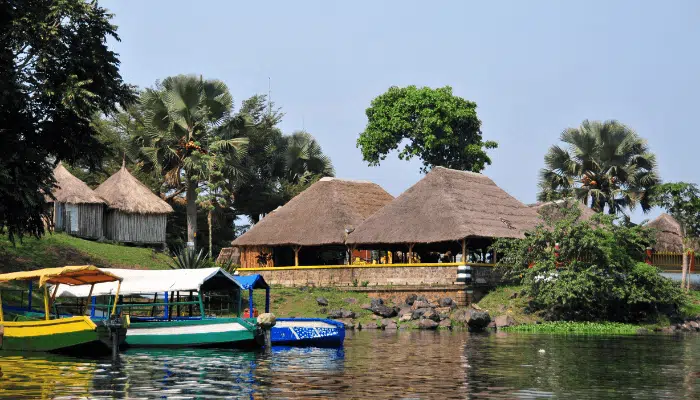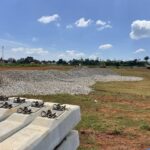The East African nation of Uganda is a landlocked region bordered by Kenya, Sudan, Congo, Rwanda and Tanzania. However, near its southern border lies Lake Victoria, which is counted among the world’s largest lakes, spanning the territories of Kenya and Tanzania as well.
Uganda also has many small rivers as it lies in the basin of the Nile. It has a rich and diverse topography but it is far from the sea hence devoid of seaports.
However, Uganda has two main inland ports and some other harbours that have been rendered defunct and underdeveloped, a consequence of the internal turmoil witnessed by the state during the civil war years.
Uganda is dependent on the port facilities of neighbouring nations like Kenya and Tanzania for its export-import trade with the world. Kenya’s main seaport lying on the coast of the Indian Ocean, the Mombasa port is utilised by Uganda for carrying out its maritime trade.
Nonetheless, the Ugandan government has undertaken measures to develop its own port facilities and terminals to reduce dependence on its neighbours such as planning a second route to the Indian Ocean via Bukasa dry port and Musoma, linked by railways to Tanga port.
However, lack of finances has often halted planning and port development projects. Uganda struggles to improve its economy which is impoverished and dependent on international aid for developing even its port infrastructure.
Although there has been slight economic growth, it has not resulted in the abatement of unemployment and poverty. Agriculture has been the backbone of the economy whereas manufacturing and services have not witnessed significant development. The country’s public sector is one of the most corrupt institutions in the world, hence foreign investment has been meagre.
The country has huge reserves of natural resources like crude oil and natural gas, and enormous scope for developing hydropower, biomass, and wind power however a slow economy has halted infrastructural growth and international trade as well. The major trading partners of Uganda include its neighbours Kenya, Sudan, Democratic Republic of Congo, Tanzania, Rwanda and Italy, China, India, UAE and Japan.
Uganda’s major export commodity is ground coffee, followed by dried and fresh fish, gold, cotton, tobacco and tea. The nation imports machinery, construction and transport equipment, basic manufactured goods, packaged and canned food, livestock and chemicals.
The nation’s maritime trade is indirect, carried through its two main inland ports situated on Lake Victoria, Port Bell and Port Jinja. However, these are small and rudimentary facilities capable of accommodating only one ship at a time. The government is building a new facility in Wakiso called Kampala port.
Lake Victoria is central to Uganda’s trade and receives transit goods and imports that are then distributed throughout the country. Small boats and ferries frequent the port facilities at the Lake carrying imports of all essential items.
Let us have a look at the inland ports and harbours in Uganda.
1. Port Bell
The port Bell is situated at the end of Lake Victoria, with a narrow entrance channel. It is Uganda’s main inland port handling most of its import and export trade. The government is negotiating with the World Bank for modernizing the port since it needs to be dredged for accommodating bigger vessels. Port expansion could not be achieved since the region is densely-settled, leading to increased costs, beyond the ambit of the government’s finances.

The area around the port has grown into a small industrial region as it is adjacent to Uganda’s commercial centre of Kampala. Numerous small industrial units such as Uganda Breweries, Cipla Chemicals, etc are located near the port facility. Their goods such as beer, medicines, chemicals, food, coffee, and fish are transported to the neighbouring regions through ferries and small boats.
The port facility is connected to other Lake Victoria’s ports through a wharf for ferries operating between Jinja, Port Kisumu of Kenya, Musoma, Mwanza and Dar-es-salaam of Tanzania. It is also directly linked to railways and lies on the Kampala to Jinja railway line, however, in the 1930s the railhead was at Kisumu. In mid 90’s Port Bell was directly connected with the railway easing transportation of trade goods.
Port Bell was established in the colonial period, named after a British official, Henry Hesketh Bell who worked as Uganda’s commissioner in 1906. Since then the port has not seen much development, lacks professional equipment and loading and unloading operations are carried through manpower.
2. Port of Jinja
The Jinja harbour is situated on Lake Victoria, in the southeastern part of Uganda at a height of more than 1000 m above sea level. It is the second-most important Ugandan port after Port Bell.
The Jinja town was established in 1901 by the British colonisers. It grew as an urban centre with the establishment of the railway line connecting the town. The British prompted cash crop production, and cotton and tea were transported after the establishment of a pier at Jinja. It grew further with the development of dams, which provided hydroelectric power in the late 1990s.
Currently, the town of Jinja is Uganda’s important trade centre however the port facility is in dire need of expansion and modernization. Many factories and industries are situated in the town, near Jinja port such as a steel mill, a copper smelting unit, plywood works, tobacco units, etc. A famous brewery, cloth factory along with sugarcane plantations dot the landscape. The finished products of these small manufacturing units are transported through the Jinja port, which is also connected to the Mombasa port through railways and roadways.

Currently, the town of Jinja is Uganda’s important trade centre however the port facility is in dire need of expansion and modernization. Many factories and industries are situated in the town, near Jinja port such as a steel mill, a copper smelting unit, plywood works, tobacco units, etc. A famous brewery, cloth factory along with sugarcane plantations dot the landscape. The finished products of these small manufacturing units are transported through the Jinja port, which is also connected to the Mombasa port through railways and roadways.
3. Mahathi Fuel transportation and Storage facility
This inland facility is owned by three private companies namely Mahathi Infra based in India, Kenya’s Signon group, and Uganda’s Fortune Energy. The contract for the construction of this fuel terminal was given to Mahathi Infra Limited, a construction company operating in the Oil and Natural Gas sector.
The construction began in 2017 and the facility will become operational in March 2022 as per the latest news reports. After its completion, the facility would be the biggest in the East African region, allowing the storage and transportation of petroleum and its derivatives such as gasoline, kerosene, diesel, etc through oil carriers from Kisumu port in Kenya. The fuel would be stored in this facility before being shipped to Uganda, Sudan, Burundi. This would significantly reduce transportation costs and delivery time. The budget of this project was 270 million dollars.

Situated on the northeastern coast of Nalubaale lake, spanning 12 hectares and just 35 km from Uganda’s capital Kampala, this facility is crucial for the Ugandan economy as it has led to the generation of employment opportunities for people from Kenya and Uganda.
The port has 14 tanks for storing around 70,000,000 l of diesel and duel. Uganda requires only 4,550,000 litres a day, hence the remaining can be transported to neighbouring countries. A dock measuring 220 m connected with four oil pipelines was also constructed. Berths for docking of oil carriers and four barges with a capacity of 4,500,000 litres each were also part of the last phase of the project.
4. Tororo inland port
The dry port of Tororo lies in the Ugandan city of Malaba, situated near the Kenyan border. The port facility spans 100 hectares and its construction began in 2010, however political and socio-economic issues have arrested the completion of this port project.
The port was being refurbished by the Great Lakes Ports Limited which would serve as the port authority after its completion. The government has envisaged it to be a container storage terminal for containerised goods shipped to Uganda, Burundi, Sudan and Congo.

It would do away with the numerous storage facilities utilised by Uganda at the Mombasa port for storing its containers before custom clearances and finally their import to Port Bell. This would aid the decongestion of the Kilindini harbour at Mombasa and also reduce transportation costs and reduce delivery time from 20 days to 4 days.
The port expansion also includes the construction of storage space for keeping imported automobiles, construction of custom offices, a container scanning system and the development of the nearby region as an industrial centre. This facility would reduce Uganda’s dependence on Mombasa as in the past, political turmoil, strikes at the port led to huge losses for Ugandan small shipping businesses.
5. Bukasa Inland Port
The government of Uganda planned to construct another port facility to boost the country’s trade network. The Bukasa port development started in 2019 however it stopped midway due to the government’s demand of renegotiating its financial agreement with the German port development firms and involving African companies to reduce costs.
The port is expected to become fully operational by 2030 and would comprise administration offices, wharves, multi-purpose terminals and shipyards. The port would handle around 5 million tonnes of goods every year.

The development of Bukasa would ease the transportation of import items from Dar es Salaam through railways to the port of Mwanza. Cargoes would be shipped through barges to Bukasa, thus making Uganda significantly independent and meeting the nation’s increasing maritime transport needs. Its integration into the northern corridor would boost competitiveness and decrease business costs.
6. Port of Butiaba
The port facility of Butiaba lies on the eastern coastline of Lake Albert in the northwestern region of Uganda, part of the Masindi area. Butiaba harbour was an important maritime point for transporting goods from Congo and Sudan. From Butiaba, the goods were transported by roadways to Masindi port from where they were ferried to Soroti. Finally, loaded into trains, these were sent to Mombasa for export.

In the late 90s and 2000s, the railways in the region became defunct due to lack of maintenance, hence leading to the degeneration of the Butiaba port. However, recently petroleum and oil reserves have been found near Lake Albert which means rejuvenation of port operations for transporting petroleum and oil from this harbour. However, this depends on government initiatives.
Apart from trade, Butiaba harbour attracts many tourists due to its scenic beauty and Lake Albert which is famous for bird-watching, fishing and boating.
Source: Marine Insight
















